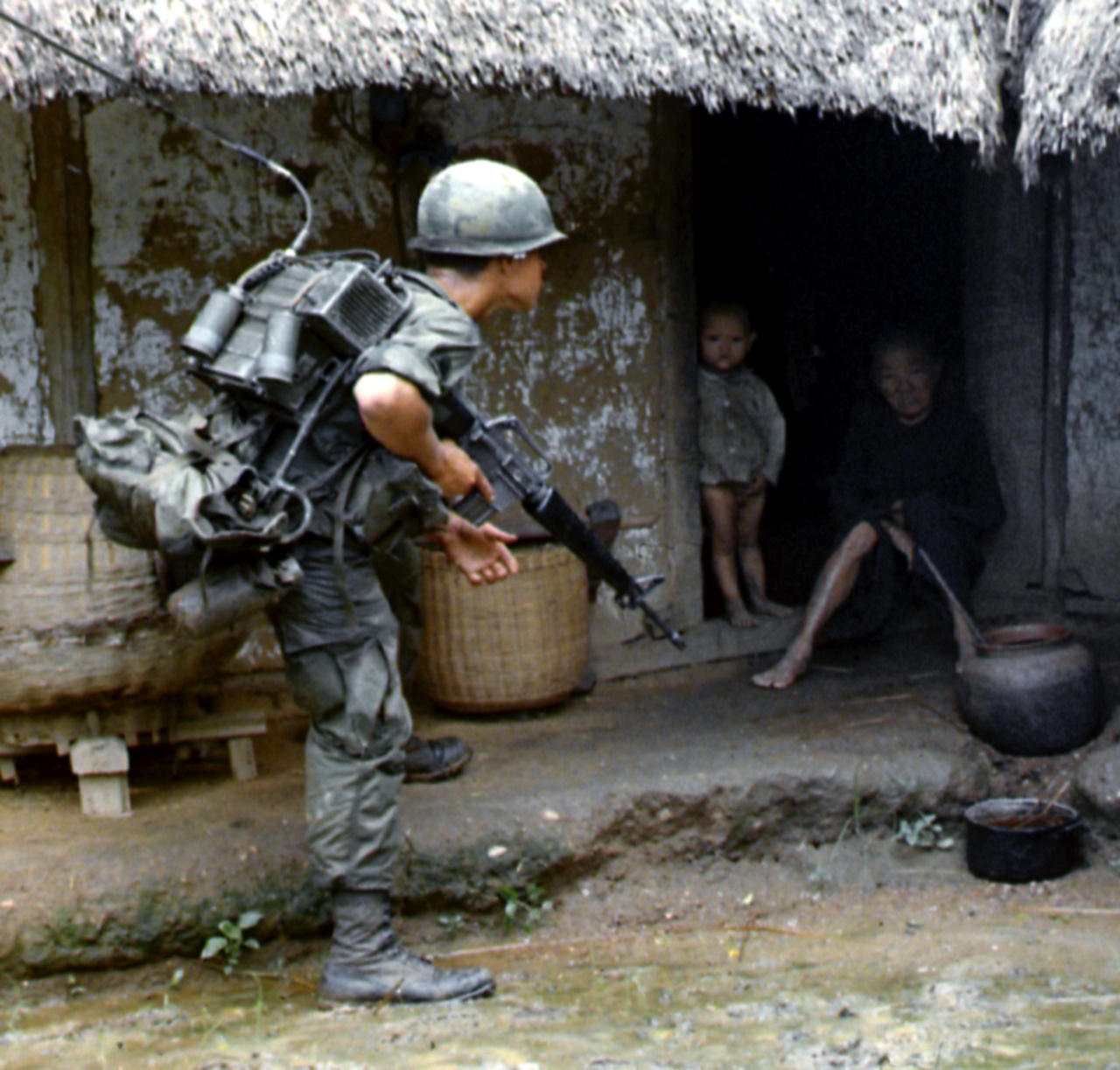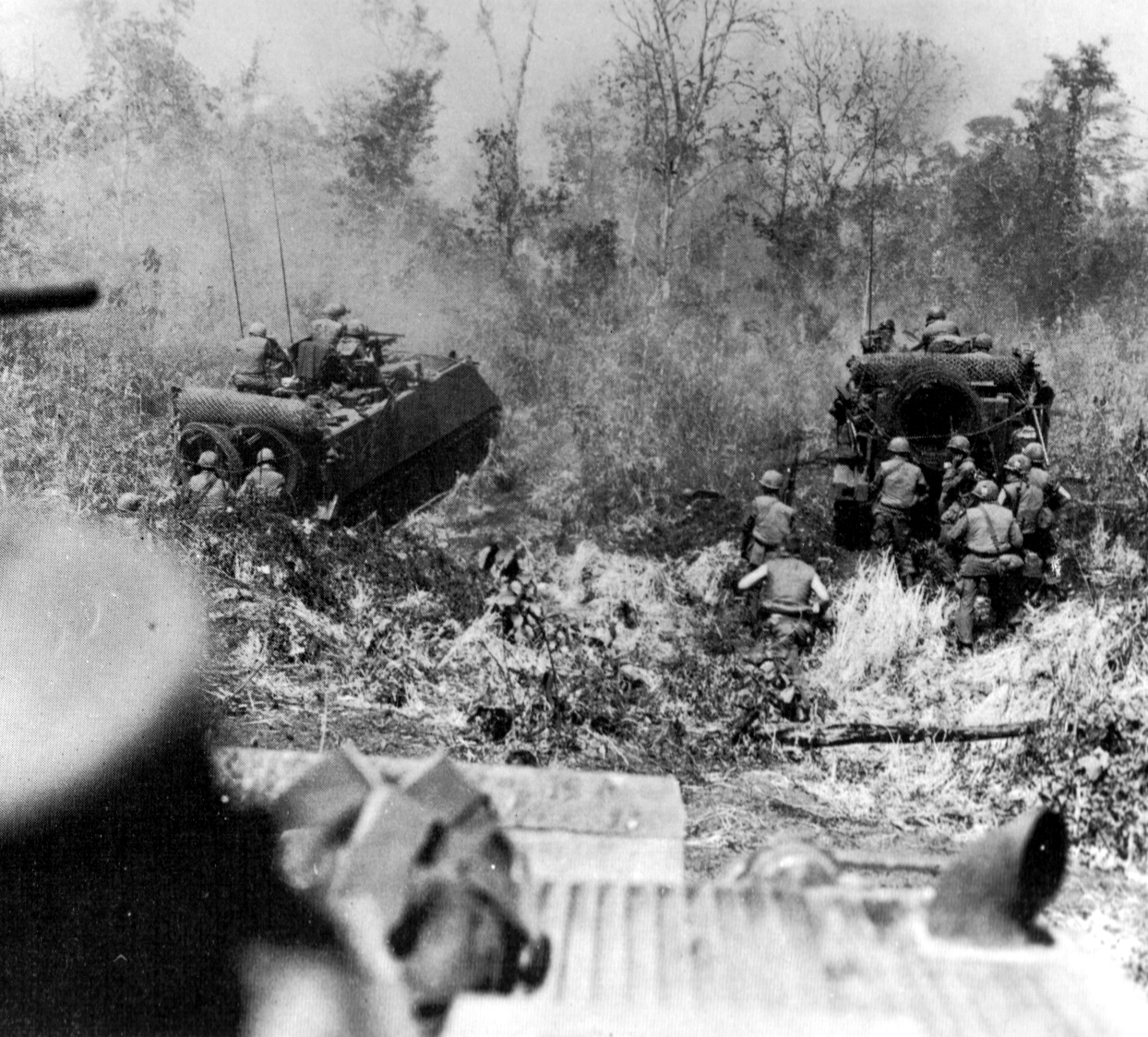|
Search And Destroy
Search and destroy, seek and destroy, or simply S&D is a military strategy best known for its employment in the Malayan Emergency and the Vietnam War. The strategy consists of inserting ground forces into hostile territory, ''search''ing out the enemy, ''destroy''ing them, and withdrawing immediately afterward. The strategy was developed to take advantage of the capabilities offered by a new technology, the helicopter, which resulted in a new form of warfare, the fielding of air cavalry, and was thought to be ideally suited to counter-guerrilla jungle warfare. The complementary conventional strategy, which entailed attacking and conquering an enemy position, then fortifying and holding it indefinitely, was known as "clear and hold" or "clear and secure". In theory, since the traditional methods of "taking ground" could not be used in this war (as all disputed territory was technically already under the control of allied forces), a war of attrition would be used, with the aim o ... [...More Info...] [...Related Items...] OR: [Wikipedia] [Google] [Baidu] |
Zippo
A Zippo lighter is a reusable metal lighter produced by Zippo Manufacturing Company of Bradford, Pennsylvania, United States. Thousands of different styles and designs have been made in the nine decades since their introduction, including military versions for specific regiments. Zippo lighters have been sold around the world and have been described as "a legendary and distinct symbol of America." In 2012, the company produced the 500-millionth unit. Since the company's inception, Zippo lighters have been primarily manufactured in the United States, although the company ran an operation from 1949 until 2002 in Niagara Falls, Ontario, Canada. Company history American inventor George G. Blaisdell founded Zippo Manufacturing Company in 1932 and produced the first Zippo lighter in early 1933, being inspired by an Austrian cigarette lighter of similar design made by IMCO. It got its name because Blaisdell liked the sound of the word "zipper," and "zippo" sounded more modern. On M ... [...More Info...] [...Related Items...] OR: [Wikipedia] [Google] [Baidu] |
Rice
Rice is the seed of the grass species '' Oryza sativa'' (Asian rice) or less commonly ''Oryza glaberrima'' (African rice). The name wild rice is usually used for species of the genera '' Zizania'' and '' Porteresia'', both wild and domesticated, although the term may also be used for primitive or uncultivated varieties of '' Oryza''. As a cereal grain, domesticated rice is the most widely consumed staple food for over half of the world's human population,Abstract, "Rice feeds more than half the world's population." especially in Asia and Africa. It is the agricultural commodity with the third-highest worldwide production, after sugarcane and maize. Since sizable portions of sugarcane and maize crops are used for purposes other than human consumption, rice is the most important food crop with regard to human nutrition and caloric intake, providing more than one-fifth of the calories consumed worldwide by humans. There are many varieties of rice and culinary preferences tend ... [...More Info...] [...Related Items...] OR: [Wikipedia] [Google] [Baidu] |
Operation Junction City
Operation Junction City was an 82-day military operation conducted by United States and Republic of Vietnam (RVN or South Vietnam) forces begun on 22 February 1967 during the Vietnam War. It was the first U.S. combat airborne operation since the Korean War and one of the largest Airmobile operations of the war. Background The stated aim of the almost three-month operation involving the equivalent of nearly three divisions of U.S. troops was to locate the elusive 'headquarters' of the Communist uprising in South Vietnam, the Central Office of South Vietnam (COSVN). By some accounts of U.S. analysts at the time, such a headquarters was believed to be almost a "mini-Pentagon", complete with typists, file cabinets, and staff workers with a large guard force. After the end of the war, the actual headquarters was revealed by Viet Cong (VC) archives to be a small and mobile group of people, often sheltering in ad hoc facilities and at one point escaping an errant bombing by some hund ... [...More Info...] [...Related Items...] OR: [Wikipedia] [Google] [Baidu] |
Saigon
, population_density_km2 = 4,292 , population_density_metro_km2 = 697.2 , population_demonym = Saigonese , blank_name = GRP (Nominal) , blank_info = 2019 , blank1_name = – Total , blank1_info = US$61.7 billion , blank2_name = – Per capita , blank2_info = US$6,862 , blank3_name = GRP ( PPP) , blank3_info = 2019 , blank4_name = – Total , blank4_info = US$190.3 billion , blank5_name = – Per capita , blank5_info = US$21,163 , blank6_name = HDI (2020) , blank6_info = 0.795 ( 2nd) , area_code = 28 , area_code_type = Area codes , website = , timezone = ICT , utc_offset = +07:00 , postal_code_type = Postal code , postal_code = 700000–740000 , iso_code ... [...More Info...] [...Related Items...] OR: [Wikipedia] [Google] [Baidu] |
Iron Triangle (Vietnam)
The Iron Triangle ( Vietnamese:'' Tam Giác Sắt'') was a area in the Bình Dương Province of Vietnam, so named due to it being a stronghold of Viet Minh activity during the war. The region was under control of the Viet Minh throughout the French war in Vietnam and continued to be so throughout the phase of American involvement in the Vietnam War, despite concerted efforts on the part of US and South Vietnamese forces to destabilize the region as a power base for their enemy, the communist North Vietnamese–sponsored and–directed South Vietnamese insurgent movement, the Viet Cong (VC). Geography The location of the Iron Triangle was between the Saigon River on the west and the Tinh River on the east and bordering Route 13 about north of Saigon. The southern apex of the "triangle" was from Phú Cường, the capital of Bình Dương Province. Its proximity to Saigon was both a reason for American and South Vietnamese efforts to eradicate it, as well as why it remai ... [...More Info...] [...Related Items...] OR: [Wikipedia] [Google] [Baidu] |
Fire Support Base
A fire support base (FSB, firebase or FB) is a temporary military encampment to provide artillery fire support to infantry operating in areas beyond the normal range of fire support from their own base camps. FSBs follow a number of plans, their shape and construction varying based on the terrain they occupy and the projected garrison. Widely used during the Vietnam War, the concept continues to be used in military operations. Under the original concept of the artillery fire support base, a 6-gun battery set up with one howitzer in the center to fire illumination rounds during night attacks and serve as the base's main registration gun. The other 5 howitzers were arranged around it in a "star" pattern. Smaller FSBs tended to vary greatly from this layout, with two to four howitzers of various calibers (usually 105 mm and 155 mm at battalion level) located in dispersed and fortified firing positions. These smaller bases arranged their guns in square or triangle patterns ... [...More Info...] [...Related Items...] OR: [Wikipedia] [Google] [Baidu] |
Artillery
Artillery is a class of heavy military ranged weapons that launch munitions far beyond the range and power of infantry firearms. Early artillery development focused on the ability to breach defensive walls and fortifications during sieges, and led to heavy, fairly immobile siege engines. As technology improved, lighter, more mobile field artillery cannons developed for battlefield use. This development continues today; modern self-propelled artillery vehicles are highly mobile weapons of great versatility generally providing the largest share of an army's total firepower. Originally, the word "artillery" referred to any group of soldiers primarily armed with some form of manufactured weapon or armor. Since the introduction of gunpowder and cannon, "artillery" has largely meant cannons, and in contemporary usage, usually refers to shell-firing guns, howitzers, and mortars (collectively called ''barrel artillery'', ''cannon artillery'', ''gun artillery'', or - a layman t ... [...More Info...] [...Related Items...] OR: [Wikipedia] [Google] [Baidu] |
Mortar (weapon)
A mortar is usually a simple, lightweight, man-portable, muzzle-loaded weapon, consisting of a smooth-bore (although some models use a rifled barrel) metal tube fixed to a base plate (to spread out the recoil) with a lightweight bipod mount and a sight. They launch explosive shells (technically called bombs) in high-arcing ballistic trajectories. Mortars are typically used as indirect fire weapons for close fire support with a variety of ammunition. History Mortars have been used for hundreds of years. The earliest mortars were used in Korea in a 1413 naval battle when Korean gunsmiths developed the ''wan'gu'' (gourd-shaped mortar) (완구, 碗口). The earliest version of the ''wan'gu'' dates back to 1407. Choi Hae-san (최해산, 崔海山) (1380–1443), the son of Choe Mu-seon (최무선, 崔茂宣) (1325–1395), is generally credited with inventing the ''wan'gu''. In the Ming dynasty, general Qi Jiguang recorded the use of a mini cannon called the Hu dun pao that ... [...More Info...] [...Related Items...] OR: [Wikipedia] [Google] [Baidu] |
Small Arms
A firearm is any type of gun designed to be readily carried and used by an individual. The term is legally defined further in different countries (see Legal definitions). The first firearms originated in 10th-century China, when bamboo tubes containing gunpowder and pellet projectiles were mounted on spears to make the portable fire lance, operable by a single person, which was later used effectively as a shock weapon in the Siege of De'an in 1132. In the 13th century, fire lance barrels were replaced with metal tubes and transformed into the metal-barreled hand cannon. The technology gradually spread throughout Eurasia during the 14th century. Older firearms typically used black powder as a propellant, but modern firearms use smokeless powder or other propellants. Most modern firearms (with the notable exception of smoothbore shotguns) have rifled barrels to impart spin to the projectile for improved flight stability. Modern firearms can be described by their caliber ... [...More Info...] [...Related Items...] OR: [Wikipedia] [Google] [Baidu] |
M18 Claymore Mine
M18 or M-18 may refer to: Aircraft * Messerschmitt M 18, an early German airliner * Miles M.18, a Miles aircraft * Mooney M-18 Mite, a low-wing monoplane * PZL-Mielec M-18 Dromader, an agricultural and aerial-firefighting aircraft Firearms and military equipment * M18 Claymore mine, an American anti-personnel landmine * M18 Hellcat, an American tank destroyer used in World War II * M18 smoke grenade, a colored smoke grenade * M18 recoilless rifle, a late-World War II recoilless rifle * SIG Sauer M18 pistol, a compact, carry sized SIG Sauer P320 used by the United States armed forces Roads and highways * M18 motorway (Great Britain) *M18 motorway (Ireland) * M-18 (Michigan highway) * M18 (East London), a Metropolitan Route in East London, South Africa * M18 (Cape Town), a Metropolitan Route in Cape Town, South Africa * M18 (Johannesburg), a Metropolitan Route in Johannesburg, South Africa * M18 (Pretoria), a Metropolitan Route in Pretoria, South Africa * M18 (Port Elizabeth), a M ... [...More Info...] [...Related Items...] OR: [Wikipedia] [Google] [Baidu] |
Ambush
An ambush is a long-established military tactic in which a combatant uses an advantage of concealment or the element of surprise to attack unsuspecting enemy combatants from concealed positions, such as among dense underbrush or behind mountaintops. Ambushes have been used consistently throughout history, from ancient to modern warfare. In the 20th century, an ambush might involve thousands of soldiers on a large scale, such as over a choke point such as a mountain pass, or a small irregulars band or insurgent group attacking a regular armed force patrols. Theoretically, a single well-armed and concealed soldier could ambush other troops in a surprise attack. Sometimes an ambush can involve the exclusive or combined use of improvised explosive devices, that allow the attackers to hit enemy convoys or patrols while minimizing the risk of being exposed to return fire. History This use by early people of ambushing may date as far back as two million years when anthropolo ... [...More Info...] [...Related Items...] OR: [Wikipedia] [Google] [Baidu] |









